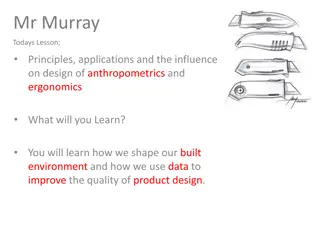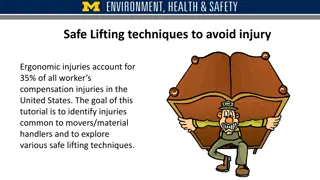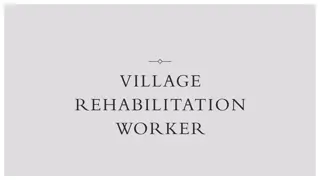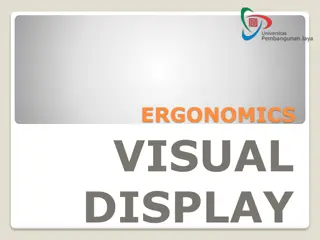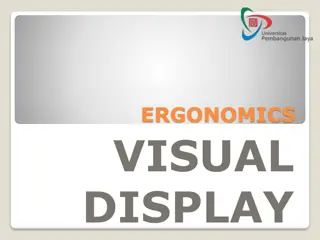Understanding Ergonomics in Design for Better Worker Health
Ergonomics, the science of designing structures and systems based on human characteristics, plays a crucial role in creating comfortable, safe, and efficient work environments. By considering ergonomic factors in the design of tools, workstations, and systems, workers can complete tasks faster, more accurately, and with fewer injuries. Ergonomics aims to reduce strain, promote good posture, and enhance overall worker well-being. Designers use ergonomics to create products that prioritize worker health and productivity.
Download Presentation

Please find below an Image/Link to download the presentation.
The content on the website is provided AS IS for your information and personal use only. It may not be sold, licensed, or shared on other websites without obtaining consent from the author. Download presentation by click this link. If you encounter any issues during the download, it is possible that the publisher has removed the file from their server.
E N D
Presentation Transcript
Ergonomics: the science of using knowledge of human characteristics to design structures and systems that are comfortable, safe and efficient. Consider the ergonomically designed snow shovel that helps prevent back strain by reducing the amount of bending a person must do.
Why ergonomics? In the 1600s doctors knew that people who worked in awkward positions for long periods of time would develop illnesses and injuries. Repetitive strain injury: damage usually to the small muscles of the wrists or hands from repeated activities over a long period of time.
With ergonomically designed products, workers can complete tasks faster, more accurately and with few injuries. Designers can create tools, workstations and systems that are easier, more comfortable and safer for workers.
Consider the design of computer workstations. Workers who spend large amounts of time on their computers are susceptible to repetitive strain injuries. Designers use ergonomics when they design workstations to make the station more comfortable to reduce strain.
These are ergonomic factors that designers consider. Tools and workstations should: Allow workers to change their position regularly. This could include standing or sitting on stools as well as chairs. (Sitting for long periods of time is unhealthy.) Reduce the amount of force or effort a task requires. Power tools rather than hand tools help reduce strain. Promote good posture. A worker s back, neck and wrists should remain straight and arms close to the body. Equipment should be within easy reach.
Have you ever wondered why the letters of a keyboard are positioned the way they are?
People originally used manual typewriters that worked by pressing down on a letter that caused a metal arm with a raised form of the letter to lift up. The metal arms would often jam because of crossing each other. The designer rearranged the letters with the most frequently typed letters spread out. This layout slowed the typist down and ensured the letters would not jam as often. So, the letter arrangement is not ergonomically designed!
Engineers today take ergonomics into consideration when designing structures, but they also need to consider other factors such as accommodating people with special needs.
What accommodations does Lawfield have for people who need to use a wheelchair? Many people have many different kinds of physical challenges. Buildings that are accessible are designed for people with special needs. People with special needs have had a long struggle to get their needs addressed in structural design.
Designers began to pay more attention to special needs after WWII when many war veterans returned home with injuries. Ramps to homes and offices were built. Elevators had Braille lettering and included sound. More accommodations were included in designs.
Universal design: an arrangement of the components of a structure or device resulting in the most user-friendly product possible. Which of these doorknobs would be easier to turn with wet hands or sore wrists?
Buildings need to be accessible to everyone. Now buildings are designed so simple tasks are convenient for all people. Universal design is more functional than basic accessible design as it considers special needs due to injury, illness or old age to be a normal part of the human range. We are all in this together.
There 4 main principles to universal design. Universally designed structures should be: Flexible for all users (for wide range of abilities) Simple to use and informative (easy to use, whatever the user s experience, knowledge, language skills or physical abilities) Safe and tolerant of errors (provides warnings and safety features in case of errors) Ergonomic (reduces need for excess force or repeated actions)


